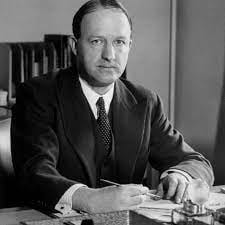Staff Changes.
Schools are not the only institutions where staff changes are par for the course. One of the big stories from the September 2021 Cabinet reshuffle was the change at the top of the DfE, with Gavin Williamson being ‘off-rolled’ and Nadhim Zahawi subject to a ‘managed move’. Mr Zahawi becomes the 38th person in government to head up education since 1944. MARK WILLIAMS takes a look at the history of this job in facts and figures.
Status.
Before 1944, there was no Minister for Education. Instead, there was a Board of Education, and the Board had a Chair. The 1944 Education Act changed this, and the office of Minister for Education was created

Rab Butler: Not only the first Minister for Education, but a one who had a major hand in creating the role.
The first Education Ministers did not sit in the Cabinet. It wasn’t until 1953 that the office was elevated to Cabinet-level status.
Titles.
Since 1944 there have been seven job title changes for the role performed by the politician with overall responsibility for Education. Some of these have reflected how the job remit has also changed.
Between 1944 and 64 it was Minister of State for Education.
Between 1964 and 1992 it was Secretary of State for Education and Science.
Between 1992 and 1997 it was Secretary of State for Education.
Between 1997 and 2001 it was Secretary of State for Education and Employment.
Between 2001 and 2007 it was Secretary of State for Education and Skills.
Between 2007 and 2010 it was Secretary of State for Children, Schools, and Families.
Between 2010 and the present it has been Secretary of State for Education.
Further Education, Higher Education, and Adult Education.
Responsibility for this has changed hands three times since 2007.
Until 2007 the Secretary of State had overall responsibility for education at all levels.
In 2007, responsibility for further, higher and adult education became the job of a new Secretary of State for Innovation, Universities and Skills.
In 2009 that role was abolished, and responsibility for FE, HE and Adult ed passed to the Secretary of State for Business, Innovation and Skills.
In 2016, FE, HE and Adult ed came back into Secretary of Sate for Education’s portfolio, where it has remained since.
Headcount.
Since 1944, 38 people have occupied the post of Minister/ Secretary of State for Education.
23 of them have been Conservatives
15 have been Labour.
29 of these ministers have been men.
9 have been women.

Ellen Wilkinson. Minister of Education 1945-1947
Since the 1997 General Election, there have been 12 Secretaries of State for Education.
Since 2010 there have been 6 Secretaries, all Conservatives
Does this mean Education is something of a ‘revolving door’ ministry?
Not really.
Compared to a similar ‘middle ranking’ department, in the same period of 1944 to the present there have been 40 different Ministers (later Secretaries of State) for Transport.
In Health- a somewhat higher profile department than Education, and perceived by some as having higher ministerial rank- there have been 33 Ministers/ Secretaries of State.
How does it compare with the four ‘great offices of state’ of Prime Minister, Chancellor of the Exchequer, Foreign Secretary and Home Secretary? As they are both domestic portfolios, let’s compare Education directly to the office of Home Secretary. Since 1944, 30 different people have held this post (Roy Jenkins serving two separate stints).
With so many factors influencing how long someone stays in post as a Minister- not least Cabinet reshuffles and general elections- perhaps the overall conclusion we could come to is that all ministries are to some extent ‘revolving door’ institutions.
Attendance record:
Not including Mr Zahawi, the majority of Ministers for Education since the War (25 of them) have served between one and two years in office.
7 ministers were in office for less than a year
12 ministers served for more than a year but didn’t make it to a second
13 ministers served over two years but didn’t make it to a third
2 ministers were in office for over three years, and
4 ministers have served over four years in office.
The five longest serving Education Minsters are as follows:
George Tomlinson (Labour) served 4 years, 8 months and 16 days between 1947 and 1951 under PM Clement Attlee.
Sir Keith Joseph (Conservative) served 4 years, 8 months and 7 days between 1981 and 1986 under PM Margaret Thatcher.
Michael Gove (Conservative) served 4 years, 2 months and 3 days between 2010 and 2014 under PM David Cameron.
David Blunkett (Labour) served 4 years, 1 month and 7 days between 1997 and 2001 under PM Tony Blair.
Margaret Thatcher (Conservative) served 3 years, 8 months and 12 days between 1970 and 1974 under PM Edward Heath.
Not-so-long service…
There are some intriguing stories behind some of those who spent less than a year in this particular job.
Rab Butler (9 months and 22 days between 1944-45) took up a different Cabinet post when the Wartime Coalition was dissolved and the new Caretaker Government was set up. However, it should be pointed out that if we add Butler’s service as Chairman of the previous Board of Education to his time as Minister for Education, then his total service heading up education in this country is 3 years and 10 months, between 1941 and 1945. During this time he oversaw the development and passing of the 1944 Education Act.
Succeeding Butler, Richard Law (Con.) served for 2 months and 1 day in the Caretaker Government that governed briefly between the end of the Wartime Coalition in May 1945 and the July 1945 General Election.
Michael Stewart (Lab.) served as Harold Wilson’s first Education Minister for 3 months and 4 days between October 64 and January 65. He left the education job to fill an urgent gap elsewhere in Cabinet under very particular circumstances. Stewart’s colleague Patrick Gordon Walker had been MP for Smethwick and Labour’s shadow Foreign Secretary before the 1964 election. Walker lost his seat that year in highly controversial circumstances, but was appointed as Foreign Secretary anyway (an unusual situation because he was neither a sitting MP nor a member of the Lords). Walker eventually resigned after fighting and losing a Parliamentary by-election in Leyton. Michael Stewart was moved from Education and made Foreign Secretary to quickly fill the breach.
Stewart’s successor at education was Anthony Crosland (2 years, 7 months, 7 days). By a twist of fate, Crosland’s successor as Minister for Education was none other than Patrick Gordon Walker, by then an MP once more, and who chalked up 7 months and 8 days in the job during 1967-68.

Patrick Gordon-Walker Secretary of State for Education and Science 1967-1968
And finally, an assortment of facts:
To date, the only Minister of Education to die in office is Ellen Wilkinson (6th February, 1947).
In later life, Sir Edward Boyle (Conservative Minister for Education between 1962 and 64) was Vice-Chancellor of Leeds University. The University’s Sir Edward Boyle Library was named in his honour.
Reg Prentice (Labour) was Secretary of State for Education and Science during 1974-75. Later on he left the Labour Party and in the 1979 election he stood as a Conservative candidate. He was returned as an MP in a different constituency, serving as Minister of State for Social Security under Margaret Thatcher between 1979 and 1981.
Another former Labour Education Minister who changed parties was Shirley Williams (1976-79), famously one of the ‘gang of four’ who founded the SDP in 1981.
Most Secretaries of State for Education have been variously promoted, demoted, shuffled sideways, or relieved of Cabinet duties. By contrast, Labour Education Secretary Estelle Morris was a high-profile resignation in 2002. In her letter of resignation to Tony Blair she referred to her work first as Schools Minister and then as full Secretary of State for Education, writing that “in many ways, I feel I have achieved more in the first job than I have in the second”. It should be remembered that Ms Morris’s candour earned her sympathy and understanding in many quarters at the time.
The role of Secretary of State for Education is widely perceived as a middle ranking cabinet position. Has it been a position from which ambitious politicians have been able to climb further up the ‘greasy pole’? Not necessarily. Of the 38 people to have held the post since 1944, only 9 people- 8 men and 1 woman- have gone on to hold one of the great offices of state:
Rab Butler: Chancellor of the Exchequer, Foreign Secretary, and Home Secretary
Michael Stewart: Foreign Secretary
Anthony Crosland: Foreign Secretary- he died in office in 1977
Patrick Gordon Walker: Foreign Secretary before later becoming Education Secretary- see above
Kenneth Baker: Home Secretary
Kenneth Clarke: Home Secretary and Chancellor of the Exchequer
David Blunkett: Home Secretary
Charles Clarke: Home Secretary
Alan Johnson: Home Secretary.
The only woman to have headed up the Department of Education since the War and then gone on to hold a great office of state is Margaret Thatcher, who of course became Prime Minister. Not only that, but she is the only post-war Education Secretary to have attained the top job.
So where next for Mr Zahawi? If history is any guide, we’ll probably know in a year or two…

Current incumbent: Nadhim Zahawi
Mark Williams is Secretary of the Fabians Education Policy Group.

